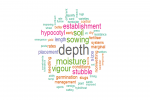Computer modelling innovation expected to offer significant economic benefits
An impact analysis has found that flowering time calculators stand to return $54.80 worth of benefits for every $1 invested in GRDC’s National Phenology Initiative (NPI).
Yield penalties for sowing wheat and barley outside the optimal period can be severe, estimated at about 25 and 17 kilograms per hectare per day for wheat and barley respectively. Since 2017, two GRDC investments made through the NPI have sought to provide more accurate guidance around when to sow to minimise these losses.
These investments have culminated in the development of flowering time calculators that support sowing date and cultivar selection for various environments.
The challenge
Growers use a combination of sowing date and variety selection to maximise wheat and barley grain yields. Prior to innovations delivered through the NPI, a lack of accurate, region-specific and timely information limited the ability to optimise sowing time decisions.
For example, sowing guides covered broad regions and optimal periods were spread over several weeks. The time window was further broadened by marking as ‘acceptable’ periods prior to and after the optimal dates.
This sowing information was also expensive to generate and required a wide number of trials and site locations nationally. That meant when flowering time calculators were developed, they were too expensive to keep updating for new varieties.
Industry needed more scalable, localised and cost-effective ways to deduce optimal sowing dates, so growers had access to clear advice.
The response
In 2017, the NPI was launched with LaTrobe University, the CSIRO and other partners, which later included the University of Melbourne as the lead organisation. A total of $12.1 million (in June 2024 dollars) was invested across two phases: an initial project that targeted wheat and barley, and a follow-on project.
The first phase exploited an improved understanding of why cultivars flower when they do. It involved the development of a new Cereal Anthesis Molecular Phenology (CAMP) model. This was embedded within the crop growth simulator APSIM-NG (the Agricultural Production Systems sIMulator – Next Generation).
The CAMP model drew on the latest genetic and physiological understanding of how wheat and barley progress through their life cycle in response to temperature and day length. The model was designed so that parameters could be set based on genotypic data, replacing the need for field experiments.
In phase two, the CAMP model is being refined and developed into a free digital tool that enables all growers and agronomists to access information on optimal sowing dates for different varieties and environments.
The impact
Expected benefits to growers from the CAMP-based sowing time tools were analysed by Marsden Jacob Associates in 2024.
The analysis found that all growers have access to an online user interface that provides accurate, relevant and timely information relating to sowing time and cultivar selection.
The economic benefit from the availability of this tool was estimated to have a gross margin worth of $10.30 per hectare.
This calculation assumed that wheat and barley yield losses amounted to 1.1 and 0.7 per cent per hectare respectively for every day the crop was sown outside its optimal flowering period. The final figure was calculated by dividing the projected benefit in the year 2032 (when adoption is expected to be around 50 per cent of peak adoption) by the total wheat and barley cropped area.
The development of a calibrated and validated model was found to remove the need for regular, costly and time-consuming time-of-sowing by variety trials. This means growers gain access to reliable recommendations three to five years earlier and at a reduced cost.
The analysis also showed a benefit to breeders and researchers, who gained access to an accurate phenology model (APSIM-NG) that better simulates the impact of genetics and environmental interactions on crop development.The investment also produced a new cereal phenology classification framework, called the Australian Cereal Phenology Classification (ACPC) system.
Overall, Marsden Jacob Associates estimated that the project is likely to deliver benefits with a present value of about $661.4 million to the Australian grains industry. This amounts to a benefit–cost ratio of 54.8 and an internal rate of return on investment of 17 per cent.
The analysts noted that the benefits were large as the project outputs were expected to affect a large proportion of wheat and barley crops.
More information: Delivering impact case studies.
Resources: Crop flowering; Crop Flowering Calculator – An online tool to assist sowing date decisions for wheat, barley and canola.

























































